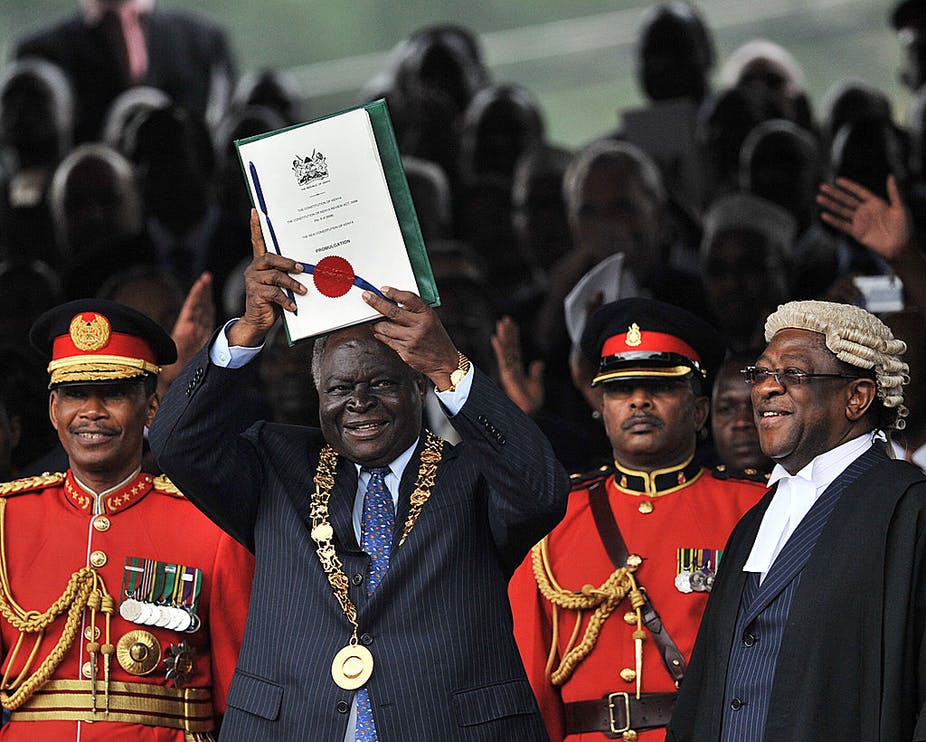The Court of Appeal of Kenya has upheld the High Court’s ruling that attempts to overhaul the country’s constitution violated its basic structures.
The mega-constitutional amendment bill proposed amending virtually every major part of Kenya’s constitution. It ran to 45 pages, contained 74 amendment articles, and included two schedules appended to the main text.
The Constitution Amendment Bill 2020 emerged from a political initiative launched by Uhuru Kenyatta and his political rival Raila Odinga, the leading contenders for the presidency in 2017. The poll was marred by serious human rights violations, including unlawful killings and beatings by police. The initiative – called the Building Bridges Initiative – was touted as a means to improve governance and prevent future post-election violence.
The dozens of amendments would have effectively left none of the existing constitution unchanged – either expressly or by implication. Among its most controversial amendments were proposals that would have undermined the separation of powers among the executive, parliament and the judiciary.
The Court of Appeal accordingly concluded that the bill amounted to a dismemberment of the Kenyan constitution. Among the seven judges, four referred to the concept of “constitutional dismemberment” in arriving at their collective conclusion that the constitutional bill exceeded the authority of amending actors.
Justice Daniel Musinga, president of the Court of Appeal, observed that
any amendment that alters the constitution fundamentally is not an ordinary constitutional amendment. It amounts to the dismemberment of the constitution.
For her part Justice Hannah M. Okwengu seized on the
distinction between amendment and dismemberment or change and remaking of a constitution.
Justice Patrick O. Kiage described the Building Bridges Initiative as
effectively dismembering the constitution, blasting so huge a hole in it as to pulverise, and essentially create a new constitutional order.
And Justice S. Gatembu Kairu stressed that the initiative was possible “provided the amendments proposed do not amount to dismemberment.”
What are the conceptual foundations of constitutional dismemberment in the context of this historic judgment?
A constitutional amendment, properly defined, is a constitutionally continuous change to higher law. It is a change whose content and form are consistent with the existing design, framework and fundamental presuppositions of the constitution.
A constitutional amendment entails unbroken unity with the constitution being amended. It therefore continues the constitution-making project in line with the existing design of the constitution.
An amendment may:
improve on the constitution’s design where necessary or useful to align expectations about how it should function,fix a constitution’s design flaws when they are discovered,restore a constitution’s earlier meaning, orreform the structure of government.
But in all cases, an amendment must cohere with the constitution. An amendment must never push the boundaries of the constitution any further than its outermost limits.
The Court of Appeal concluded that the proposed changes exceeded the boundaries of the constitution of Kenya.
It was not an amendment, properly understood. It was a constitutional dismemberment.
A constitutional dismemberment entails a fundamental transformation of the constitution’s core commitments. Constitutional dismemberment alters the identity, the fundamental rights, or the structure of the constitution. It intends deliberately to disassemble one or more of a constitution’s elemental parts. It can occur suddenly in a big-bang moment or gradually by erosion or accretion.
To use a rough shorthand, the purpose of a constitutional dismemberment is to unmake and remake the constitution.
The point is that a constitutional dismemberment is a far-reaching alteration that is incompatible with the existing framework of the constitution. It exceeds the boundaries of amendment and it endeavours to set the constitution and the country on a new course.
Efforts to dismember constitutions are quite common. We have seen amending actors around the world pass constitutional dismemberments that defy the basic structure of the constitution. This happened in Brazil, Turkey, Albania, Japan, Colombia and Greece. Sometimes courts have intervened – as was the case in Kenya.
We can now explain why the Kenyan Court of Appeal described the constitutional bill as a constitutional dismemberment. It tried to override the fundamental features of the constitution using the ordinary procedures of constitutional amendment.
But changes as far-reaching as these cannot be made using ordinary amendment procedures. And that is a significant part of the reason why the Court of Appeal declined their appeal.
An earlier version of this analysis was published by I-Connect
Richard Albert, Professor of World Constitutions and Director of Constitutional Studies, University of Texas at Austin
This article is republished from The Conversation under a Creative Commons license. Read the original article.



